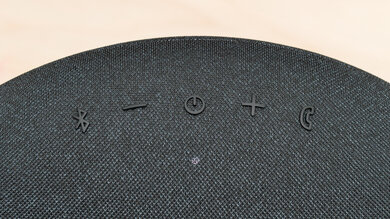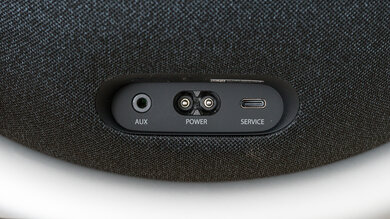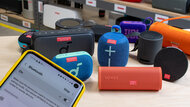The Harman/Kardon Onyx Studio 8 is a premium wireless speaker with a unique aesthetic that makes it a great centerpiece for your home decor. Its convex shape and ring-shaped carrying handle means it's easily carried around from room to room, and its advertised eight hours of battery life means you won't need to keep it plugged in constantly. It also features a dual-tweeter design for stereo playback and Bluetooth multipoint connectivity, so you can pair it with up to two devices at the same time.
Our Verdict
The Harman/Kardon Onyx Studio 8 is decent for music. It has a relatively balanced default sound profile that's well-suited to a variety of music genres. Though, like many small speakers, it lacks low-end rumble, a pleasing bump in the high bass helps bring out basslines. The mid and treble ranges also have plenty of detail to render vocals and lead instruments in a nuanced way. However, its speaker configuration means stereo separation only occurs in the treble range, as there's only one dedicated speaker for the low and mid frequencies. Audio also won't sound consistent from different listening angles due to its design. That said, it can get quite loud, though there are some compression artifacts at max volume.
-
Balanced default sound profile.
-
Stereo playback without downmixing to mono.
-
Room correction feature.
-
Directivity isn't the best.
-
Poor battery life performance.
-
No IP rating against water or dust.
The Harman/Kardon Onyx Studio 8 is mediocre for watching videos and movies. Its balanced mids and treble mean dialogue and speech sound clear and present, but the lack of low-bass rumble robs action-packed scenes of excitement. While it can get quite loud, there's compression present at max volume, and audio reproduction can be inconsistent as it depends on how you're positioned relative to the speaker. Latency with iOS and Android devices is also quite high, so you'll notice lip sync issues. Different apps compensate for latency differently, so your experience may vary.
-
Balanced default sound profile.
-
Stereo playback without downmixing to mono.
-
Room correction feature.
-
Directivity isn't the best.
-
High latency with iOS and Android devices.
-
No IP rating against water or dust.
The Harman/Kardon Onyx Studio 8 is good for podcasts. It has a balanced, relatively flat mid-range response that's well suited for speech and vocal content so it'll bring out the detail in your favorite podcasters' voices. It's also very portable, so you can bring it around with you while you listen to a podcast. However, while it can get quite loud, there's some compression present at max volume. Its directivity isn't the best either, so audio won't sound consistent from every listening angle.
-
Sleek, unique and lightweight design.
-
Balanced default sound profile.
-
Stereo playback without downmixing to mono.
-
Room correction feature.
-
Directivity isn't the best.
-
Poor battery life performance.
The Harman/Kardon Onyx Studio 8 has no voice assistant compatibility, so it's unsuitable for this use.
The Harman/Kardon Onyx Studio 8 is adequate for outdoor use. It's battery-powered, so it doesn't need to be plugged in to operate. That said, we measured the battery life at a little below seven hours, which won't be enough to get you through a camping trip without a recharge. It also lacks an IP rating for protection against the elements, and audio doesn't sound consistent across all listening angles. However, it's portable enough to carry with one hand, and its balanced default sound profile means it can still be a hit at smaller outdoor gatherings.
-
Sleek, unique and lightweight design.
-
Balanced default sound profile.
-
Stereo playback without downmixing to mono.
-
Directivity isn't the best.
-
Poor battery life performance.
-
No IP rating against water or dust.
- 7.0 Music
- 6.1 Videos/Movies
- 7.5 Podcasts
- 2.8 Voice Assistant
- 6.6 Outdoors
Changelog
-
Updated Apr 14, 2025:
We referenced the Harman/Kardon Onyx Studio 9 in the App box.
-
Updated Dec 05, 2024:
We referenced the Harman/Kardon Go + Play 3 in the Dynamics box.
- Updated Mar 25, 2024: Review published.
- Updated Mar 18, 2024: Early access published.
- Updated Mar 11, 2024: Our testers have started testing this product.
Check Price
Differences Between Sizes And Variants
The Harman/Kardon Onyx Studio 8 is available in three color variants: 'Black,' 'Blue,' and 'Champagne.' We tested the 'Black' variant but expect all different color variants to perform similarly. You can see its label here.
If you encounter a different variant of this speaker, please let us know in the forums, and we'll update our review.
Compared To Other Speakers
The Harman/Kardon Onyx Studio 8 is a premium Bluetooth wireless speaker with Bluetooth multipoint connectivity and a built-in room correction feature that adapts the sound profile to the unique characteristics of your room. It has a more balanced default sound profile than its predecessor, the Harman/Kardon Onyx Studio 6. It can also play back stereo content without downmixing to mono, which is a step up from the last generation. However, it lacks the previous generation's IPX7 rating for water resistance, meaning it's better suited as an indoor speaker where the elements can't damage it. It also lacks the voice assistant capabilities of other premium speakers like the Apple HomePod (2nd generation).
See also our recommendations for the best Bluetooth speakers, the best home speakers, and the best speaker brands.
The Harman/Kardon Go + Play 3 and the Harman/Kardon Onyx Studio 8 are home Bluetooth speakers that share Harman's stylish design language. Of the two, the Onyx Studio 8 is the more visually arresting, with a wraparound band that doubles as a stand and handle. The Play 3 resembles a more traditional boombox. Ultimately, the Play 3 is the better pick for most people. It gets louder, reproduces bass more accurately, and is also cheaper. The Onyx Studio 8 is a bit lighter though, so if you'd prefer a speaker that's easier on the arms when moving from room to room, that's the one to pick.
The Harman/Kardon Onyx Studio 8 is the predecessor to the Harman/Kardon Onyx Studio 9. Where the Studio 8 stood out for its arresting design, with the entire speaker framed by an aluminum wraparound handle, the Studio 9 has a more traditional, laid-back oval design. Both speakers are easy to carry around your house and sound fairly similar. The main difference is the addition of companion app support to the Studio 9, giving you access to a 7-band EQ to tweak the sound to your heart's desire.
The Harman/Kardon Onyx Studio 8 is a better all-around speaker than the Harman/Kardon Aura Studio 3. While the Aura Studio 3 is a wired speaker, the Onyx Studio 8 can run off a battery, meaning it can be used outdoors or more easily set up in different rooms. The Onyx Studio 8 is also better built, has a more balanced default sound profile, and has better controls. That said, the Aura Studio 3 has better directivity and lower latency with iOS and Android devices.
The Harman/Kardon Onyx Studio 8 is a step up from the Harman/Kardon Onyx Studio 6 in many ways, though it lacks its predecessor's IPX7 rating for water resistance. The new generation has a more balanced default sound profile, a longer continuous battery life and it can playback stereo content without downmixing to mono. It also has better controls, allowing you to accept and decline calls, as well as pair with another Onyx Studio 8 to create a true wireless pair. However, the Onyx Studio 6 has lower latency with iOS and Android devices, making it a good choice if you watch a lot of videos or movies.
The Harman/Kardon Onyx Studio 8 and Apple HomePod (2nd generation) are both premium speakers that cater to different needs. The Harman/Kardon can be operated wirelessly and has better portability, making it a better choice for on-the-go listening. You can also use it to stream audio via Bluetooth, which isn't possible on the Apple. The Apple has a different feature set, with WiFi compatibility and excellent voice assistant integration. It's better suited to acting as a smart speaker hub to help integrate other smart devices. It also has iOS compatibility, so you can adjust a bevy of settings via your iOS device. Both speakers have similarly balanced default sound profiles, though, and feature room correction tools to bring out the best of your unique acoustic space.
The Harman/Kardon Onyx Studio 8 and the Bose SoundLink Revolve+ II are both wireless speakers with different strengths. The Harman/Kardon has a more distinctive look and a more balanced default sound profile. It can also playback stereo content without downmixing to mono. However, the Bose is better built, has a longer battery life, and has better controls, both on the speaker itself and via its companion app.
Test Results
The Harman/Kardon Onyx Studio 8 has a unique convex design with a sleek aluminum handle that doubles as a base for stability. There are controls accessible on the top of the unit. It looks stylish and modern and can certainly act as a centerpiece for your living room. It's available in a few color variants, including 'Black,' 'Blue,' and 'Champagne.'
The build quality is okay. The body is made of dense plastic that's covered in a tight, tear-resistant layer of fabric, and the handle is made of anodized aluminum. While it feels sturdy and well-constructed, this speaker isn't certified resistant to water, dust, or impact. The ports also don't have a flap to protect them from dust or water. While the speaker's asymmetrical design makes it look unstable, there are actually rubber feet on the handle ring and smaller rubber feet on the fabric of the speaker's body that help balance the speaker on any surface.
The control scheme is good. The rubberized buttons are raised from the surface of the speaker, and they're clicky and responsive. There's also a decent amount of audiovisual feedback with these controls. The speaker beeps when you hit max volume and chimes when you enter Bluetooth pairing mode. A small light under the power button flashes red when the battery is low and blue when entering Bluetooth pairing mode. That said, there's no other feedback given for volume changes or minimum volume.
'+' and '-' buttons:
- Single tap: Increases or decreases the volume.
Power button:
- Single tap: Turns the speaker on/off.
Call button:
- Single tap: Answers a call. Plays/pauses track.
- Double press: Rejects/ends a call. Skips to the next track.
- Triple press: Skips back to the previous track.
Bluetooth button:
- Single tap: Pairs with a Bluetooth device.
- Press and hold: Activates 'Wireless Stereo Boost' mode to pair with another Onyx Studio 8 speaker.
The controls themselves are simple enough to use but are hampered by their confusing and unreliable double/triple functions. We found that the speaker often wouldn't register the correct amount of taps and would input the wrong command. When paired with another Onyx Studio 8 speaker, there are a few smaller lights on the back of the speaker that tell you whether the speaker is playing back on the left or right channel.
The Harman/Kardon Onyx Studio 8 has good frequency response accuracy. It has a relatively balanced response across the entire range. Like most small speakers, it struggles to reproduce low bass, so there's not much low-end thump or rumble. However, a slight bump in the high bass helps bring out basslines and kicks. The mid and treble range is also quite flat and detailed, so vocals and speech are reproduced clearly. This speaker also has an automatic room calibration feature that tailors its output to your room's unique acoustics. Beyond this, there aren't any sound enhancement features like an EQ or presets.
This speaker has a decent soundstage performance. It can playback content in stereo, without downmixing to mono. However, the configuration of the speakers means that only the higher frequencies have full stereo separation. Two tweeters handle these frequencies, and one larger driver in the center handles bass and mid frequencies. As a result, if you listen to a track with elements that are intentionally panned hard-left or hard-right, like Eleanor Rigby by the Beatles, you'll notice that it's only the higher frequency ranges that seem to have any stereo width. Its directivity is okay, though its convex shape means that audio won't sound consistent from all angles around the speaker.
This speaker has a passable dynamics performance. While it can get loud enough to fill your living room with sound, it's not quite loud enough for outdoor parties or larger events. Some compression and pumping artifacts also become more pronounced as you crank the volume. The Harman/Kardon Go + Play 3 gets quite a bit louder and with less compression at high volumes, though it is also a larger speaker.
The battery life performance is poor. The manufacturer advertises eight hours of battery life off a single charge, but we measured it to be a little less than seven hours. However, battery life tends to vary on usage, so your experience may differ. This speaker also doesn't have an auto-off feature, so you'll need to manually switch it off to preserve the battery life.
Unlike the Harman/Kardon Onyx Studio 9, the Harman/Kardon Onyx Studio 8 doesn't have a companion app. But you can still pair it with another Onyx Studio 8 speaker via the 'Wireless Stereo Boost' mode. You can activate this feature by holding down the Bluetooth button. In this mode, the LEDs at the back of the speaker will light up to indicate whether the speaker is playing back the left or right channel. You can switch the stereo orientation of the speakers by double-pressing the Bluetooth button.
The Harman/Kardon Onyx Studio 8 has an aux input you can use to connect mobile devices, like your phone or laptop, via a 3.5mm connection. There's also a USB-C port, but you can only use it to service the speaker.
The Harman/Kardon Onyx Studio 8 has decent Bluetooth connectivity. It features Bluetooth multipoint, so you can pair it with up to two devices simultaneously. Playback on the first device will end as soon as you begin playing audio from a second paired device. It has incredible range, so you can remain paired even if you're in another room. However, latency with both iOS and Android devices is high, so you'll experience sync issues between your audio and video if you're using the speaker to watch a movie or YouTube video. However, apps tend to compensate for latency differently, so your experience will vary.
Comments
Harman/Kardon Onyx Studio 8: Main Discussion
Let us know why you want us to review the product here, or encourage others to vote for this product.
Update: We referenced the Harman/Kardon Onyx Studio 9 in the App box.
- 21010
Сколько db Onyx Studio 8 добавляет, если его подключить к розетке?
The full review has been posted here. Let us know what you think!
- 21010
You bought this when the new Go+Play 3 is finally available? It’s always nice to see HK products in the list, but….you chose poorly.

































